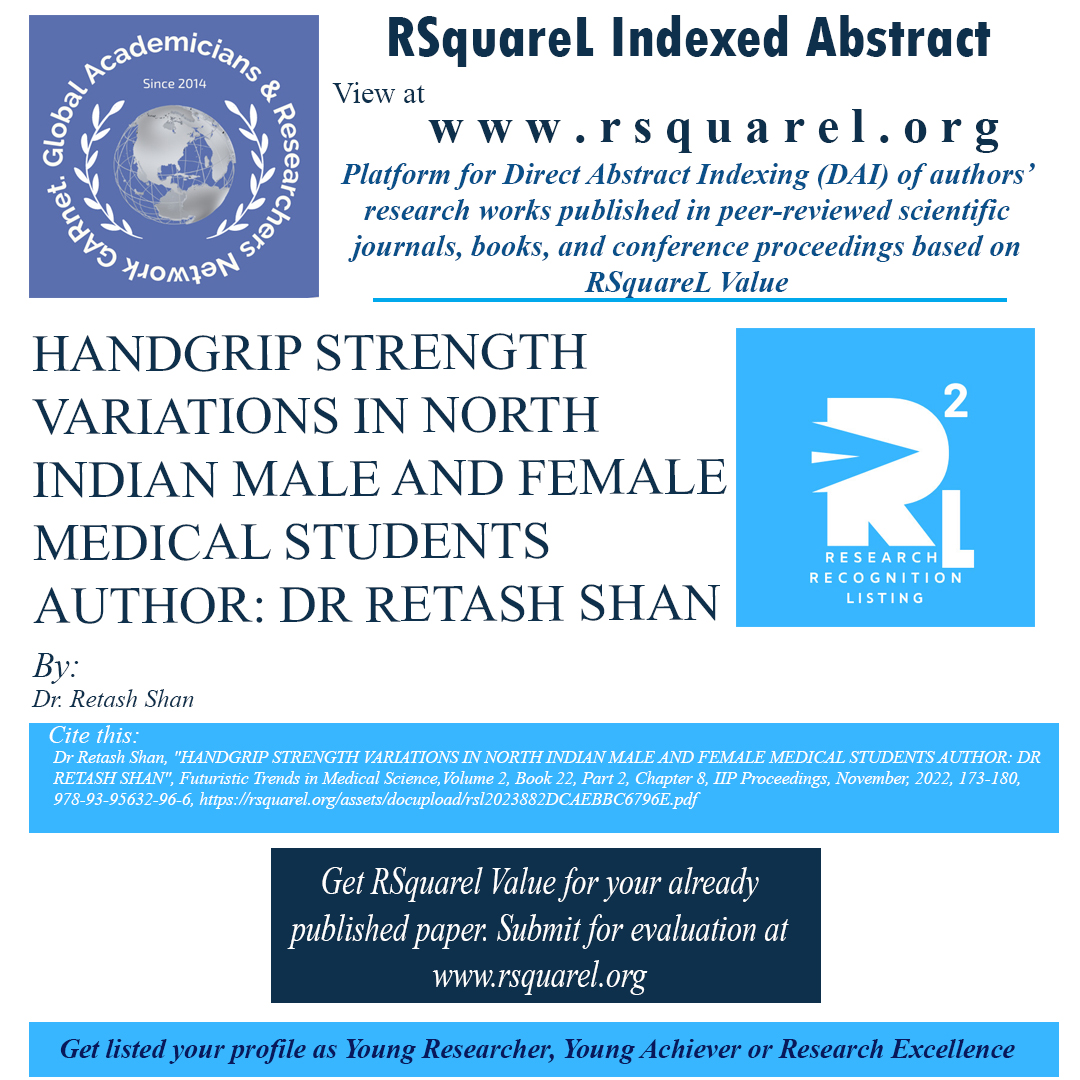editedbook
Publication: IIP Proceedings Year: 2022, Month: November Page No: 173-180, ISSN/ISBN: 978-93-95632-96-6, DOI/Link: https://rsquarel.org/assets/docupload/rsl2023882DCAEBBC6796E.pdf
HANDGRIP STRENGTH VARIATIONS IN NORTH INDIAN MALE AND FEMALE MEDICAL STUDENTS AUTHOR: DR RETASH SHAN
Area/Stream: Medical Sciences, Authors: Dr Retash Shan Keywords: Dynamometer; Female; Handgrip strength; Male; Medical Students. Book Name /series: Futuristic Trends in Medical Science,Volume 2, Book 22, Part 2, Chapter 8Publication: IIP Proceedings Year: 2022, Month: November Page No: 173-180, ISSN/ISBN: 978-93-95632-96-6, DOI/Link: https://rsquarel.org/assets/docupload/rsl2023882DCAEBBC6796E.pdf
Abstract:
Handgrip strength (HGS) is the maximum force produced during maximal voluntary contraction (MVC). It can be measured by pulling and squeezing a dynamometer with one's hand to determine the amount of static force created. The handgrip dynamometer is used to exercise upper limb muscles, particularly the forearm and hand muscles. Handgrip strength is often considered an objective measure of upper extremity functional integrity. HGS is a physiological characteristic influenced by various parameters such as gender, age, and body size. The purpose of this study was to compare men's and women's maximal handgrip strength. The current study was designed to fill a gap in knowledge on the normative levels of handgrip strength in boys and females in the Jammu region. This can offer baseline data/handgrip reference values in medical students between the ages of 17 and 20. To assess and compare Handgrip strength in healthy first-phase male and female medical subjects. A cross-sectional study including 250 healthy first-phase medical students aged 17-20 years (125 male and 125 female) was conducted in the research lab of GMC Jammu's Physiology department. Students with a history of upper limb injury/nerve damage, a significant illness, a musculoskeletal problem, or a history of medicines altering motor function were barred from participating in the study. The investigation was approved by the Institutional Ethics Committee. A handgrip dynamometer determined maximum handgrip strength (Apex International, Amritsar; Punjab; India). The grip strength of the dominant hand was tested three times at minute intervals according to the American Society ofHand Therapists (ASHT) standard testing technique, with the more excellent reading (in kg) reflecting the maximal handgrip strength for each. SPSS version 26.0 and an unpaired t-test were used to examine the data. Handgrip strength in male subjects (Mean: 41.85 kg) was statistically significant when compared to female subjects (Mean: 31.87 kg) (p < 0.001). Male individuals had stronger grips than female subjects. This study aims to provide a baseline of normative data (control values) among a sample cohort of GMC Jammu medical students. Our study, however, was limited to medical students between 17 and 20. We believe that diverse age groups should be studied.
Cite this: Dr Retash Shan,"HANDGRIP STRENGTH VARIATIONS IN NORTH INDIAN MALE AND FEMALE MEDICAL STUDENTS AUTHOR: DR RETASH SHAN", Futuristic Trends in Medical Science,Volume 2, Book 22, Part 2, Chapter 8, November, 2022, 173-180, 978-93-95632-96-6, https://rsquarel.org/assets/docupload/rsl2023882DCAEBBC6796E.pdf
Views: 4164
Download File
News
